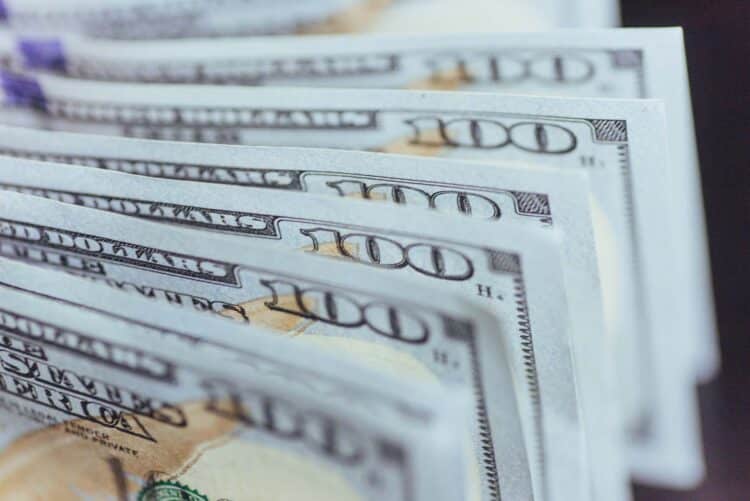How much money is in your purse or wallet right now? Is there a chance a few $100 bills are hiding out, waiting to be spent?
Before you take that money to the grocery store or put it in the bank, consider giving it a closer look. The value of your currency could be more than $100.
Although legal tender is never more than its face value, some $100 bills have more collectability than others. The best example of this is an 1863 $100 gold certificate with a PCGS EF40 rating. It sold for $2.115 million.
Value of Old One Hundred Dollar Bills
The value of an old one-hundred-dollar bill will be $100. This currency is created for legal tender, trade, and commerce. Some have more value than others because of their condition and rarity, with some examples selling for $15,000 or more. Bills in uncirculated condition from 1863 tend to have the most value.
Although the first version of the modern $100 bill began circulating during the Civil War years, the first one ever printed in the United States was on August 8, 1778. It was a colonial note, typically published by the state, and its language made it more like a contract.
Here’s what the $100 bill from North Carolina said.
“This bill entitles the Bearer to receive ONE HUNDRED DOLLARS, or the value thereof, in gold of silver, agreeable to an act of assembly passed at Hillsborough the 8th day of August, 1778.”
The original colonial bills also had a unique phrase on them: “death to counterfeit.”
Most $100 bills sell for about $130 in uncirculated condition if they’re from the 1970s. Currency from the 1960s retails for $200 to $350 in a similar state.
The most valuable option from our 20th currency for the average collector is the 1928 $100 bill with a gold seal. The value is $3,000 or more if it is in uncirculated condition. If it is a star bill, the price rises to $5,000 or more. This year is about as valuable as the 1863 series because it was the last year of the larger notes.
In 1929, the US government began printing the modern $100 bill with a slimmer profile.
Rare $100 bills with unique serial numbers or attributes can fetch more than $100,000. Older currency has a lot of different features to consider, so it is worth taking a closer look.
What Is Unique About Old $100 Bills?
The larger $100 bills issued from 1863 to 1928 were larger than modern currency. They looked more like a certificate of deposit or a stock issuance than paper money you’d use for goods or services.
Those early $100 bills represented one of several options, whereas today, they are merely legal tender notes. This older currency’s value depends on why it was issued. Here are some of the options it could be.
- Interest Bearing Notes.
- Compound Interest Treasury Notes.
- National Standard or Gold Bank Notes.
- Silver or Gold Certificates.
- Federal Reserve Notes.
Most series from the larger bills are worth at least $500 if they are listed in very good condition. A 1914 blue seal $100 bill is typically worth less than what you’ll get with the other years.
The $100 bills with a red seal mean you have a legal tender note. When there is a green seal, it represents a Federal Reserve note.
What Is the Grading System for Old $100 Bills?
The value of old $100 bills is based on whether it is in circulated or uncirculated condition. People use that currency for everyday purposes if it is the first option.
When bills are uncirculated, that means they never entered the economic system. They were protected and stored to preserve their condition.
Circulated and uncirculated bills can receive the following grading designations.
| Grading Designation | What This Grading Designation Means for Value |
| Poor | There is enough detail on the bill to identify it, the date, and the type. It shows signs of heavy wear, including punctures and tears. |
| Good | Most bills you see in circulation today would fall into this category. They’ve traded hands a few times, so there is wear and tear on the edges. Some smudges and smearing are present, along with numerous folds. It feels soft to the touch. |
| Very Good | The $100 bill looks fresh, but the digits and letters printed on it might show softness on the edges. There is still wear throughout the bill, but it has more crispness to it. |
| Fine | You’ll see a few creases or folds because the bill was likely used, but the printing and images are in excellent condition. |
| Very Fine | There is minimal wear on all the design details printed on the bill. You won’t see any discoloration or fading with the paper, and the ink marks typically have crisp edges. |
| Extremely Fine | There might be a single crease, mark, or blemish on the bill. Everything else looks like it could be an uncirculated option. |
| Uncirculated | Uncirculated bills can be created as “choice” or “gem.” Circulated currency is listed as “about uncirculated.” These items tend to have the most value for serious collectors. The best examples receive a score of 70, but anything at 63 or better is considered an excellent item. |
What Does the Star Designate on a $100 Bill?
When you see a $100 bill with a star, it means the original printing was replaced because of an error. It is against the Federal Reserve’s policy to issue currency with duplicate serial numbers, so they add the star graphic to designate what happened when creating the product.
Since printing errors are uncommon, even with older currency, the star designation for a $100 bill makes it rare. Even a $1 bill today with a star on it is likely more valuable as a collector’s item than legal tender.
That’s why it helps to pay attention to what is printed on your money. If you have a $100 star bill, it could be worth two or three times its face value in a few years.
Additional Ways for a $100 to Have Value
Some collectors like to have specific types or styles of serial numbers on the $100 bills they collect. Having one of the best examples of them, like a 00000001 bill from a popular year, can give you tremendous value.
Some collectors like to collect the highest available numbers for a printed series, while others look for repetition or binary traits.
The most valuable $100 bills tend to have a solid number sequence and be in a verified uncirculated condition. These routinely sell for six figures.
Although less valuable than some others, an error cut $100 bill could be of value to some collectors. There is a market value for these products, but the price is ultimately what someone is willing to pay for what you have.
Is the Value of $100 Bills Worth Pursuing?
As older currencies wear out and get replaced, their uncirculated versions have more collectible value. This rarity makes them an excellent option for collectors and investors to consider because of that extra premium. Scarcity with some paper $100 bills allows a few to sell for millions.
People tend to use cash. Although $100 bills are less likely to be used at stores than smaller denominations, it’s still enough value to make someone take notice.
If you can find a $100 bill with a unique serial number or attributes that make it collectible, I encourage you to hold onto it or get it graded. It could be worth a significant amount one day!


